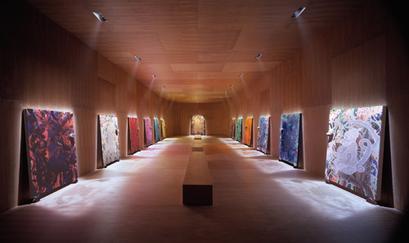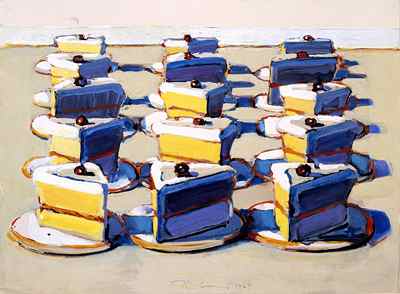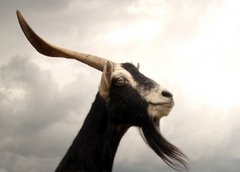Wednesday, October 21, 2009
Elements of design and composition
Tuesday, October 20, 2009
Frank Bauer


From what I can gather, Frank Bauer is a german artist who paints most of his works from photographs in a very photo-realistic style. If the photo is damaged or blurred, then that is incorporated into the painting as well, whether it be red-eye or backlighting. According to his website, Bauer paints portraits, still lives, landscapes, and nightlife scenes. I notice that his paintings of people, women especially, tend to be quite glamorously depicted...
Lucien Freud


http://upload.wikimedia.org/wikipedia/en/9/96/Freud%2C_After_Cézanne.jpg
Lucien Freud was born in Germany in 1922. Interestingly, he is the grandson of Sigmund Freud. Lucien's family moved to England in the 1930's and that is where he received his training in art. He went to Cedric Morris' East Anglian School of Painting and Drawing, and later at Goldsmith's College in England. Early in his career his paintings were often associated with surrealism, as we can see with his painting, "The Painter's Room". A lot of Lucien's later works were comprised of nude. Lucien is still alive, and his most recent paintings' subject matter largely includes horses. Lucien has a peculiar technique as well, one in which he clean his brush after every stroke.
Monday, October 19, 2009
Chris Ofili
A large walnut-panelled room designed by architect David Adjaye holds the paintings. The room is approached through a dimly-lit corrridor, which is designed to give a sense of anticipation. There are thirteen paintings altogether, six along each of two long facing walls, and a larger one at the shorter far end wall.
Each painting depicts a monkey based around a different colour theme (grey, red, white etc.). The twelve smaller paintings show a monkey from the side and they are based on a 1957 Andy Warhol drawing. The larger monkey is depicted from the front. Each painting is individually spotlit in the otherwise darkened room. The room is designed to create an impressive and contemplative atmosphere.
The paintings each rest on two round lumps of elephant dung, treated and coated in resin. There is also a lump of the dung on each painting. Strictly speaking, each work is mixed media, comprising paint, resin, glitter, mapping pins and elephant dung. The Upper Room as a whole is described by the Tate as an "installation".
The Upper Room is a reference to the Biblical Last Supper of Jesus and his disciples, hence the thirteen paintings. Ofili states the work is not intended to be offensive, but rather to contrast the harmonious life of the monkeys with the travails of the human race."
Ofili offers a wide range of art which I will post more about later. Enjoy.
Inke Essenhigh
 Inke Essenhigh is an American Painter who studied at Columbus College of Art and Design in Ohio and the School of Visual Arts in New York. She has exhibited her work all over the U.S., from New York to San Fransisco, and all over the world, from Sao Paolo, to Belgium, to London. With her unique "pop surrealism" style, she inspired movement of young painters in New York, some of which include Cecily Brown, Damien Loeb and Will Cotton. Her style is exemplified in the painting to the right, "Optimistic Horse and Rider." Her use of flat colors and cartoon-like painting style provide a great flow.
Inke Essenhigh is an American Painter who studied at Columbus College of Art and Design in Ohio and the School of Visual Arts in New York. She has exhibited her work all over the U.S., from New York to San Fransisco, and all over the world, from Sao Paolo, to Belgium, to London. With her unique "pop surrealism" style, she inspired movement of young painters in New York, some of which include Cecily Brown, Damien Loeb and Will Cotton. Her style is exemplified in the painting to the right, "Optimistic Horse and Rider." Her use of flat colors and cartoon-like painting style provide a great flow.
David Hockney

In the video I just posted, David Hockney, a prominent British artist, talks about his views on painting, which actually reflect some of the things we've been talking about. He talks about using the fewest strokes possible, simplifying the painting, deliberately choosing a big brush. He also made me think: What types of things are unphotographable? What can't be captured in a photograph but needs the freedom of paint and canvas to be expressed?
Also, Hackney has been painting since the 50s. Each decade has given rise to a very different look for his paintings. His work in the 80s reminded me of Picasso. Here is an example...
Sunday, October 18, 2009
Jim Lambie



"Is the room expanding or contracting? … Covering an object somehow evaporates the hard edge off the thing, and pulls you towards more of a dreamscape.” --J.L.
This kind of art can drastically affect the experience of being in the space, especially a quiet one like an art gallery. The designs and patterns on the floor can heighten the emotional experience of the observer/participant walking through the gallery. I imagine the effect is often somewhat disorienting, perhaps distracting, as ones eyes want to follow the lines around the room. Also, I think this art is interesting in the way it cannot be replicated--it is completely dependent on existing within the space in which it is created.
Fred Tomaselli
Wayne Thiebaud


Wayne Thiebaud was born in 1920 in Arizona. He did most of his paintings in the 1950's and 60's. The subject matter of his paintings is mostly baked goods such as pies and cakes. His work is a part of the Pop Art movement, but he painted during the very beginning of the movement. He typically uses brilliant colors and shadows in his paintings.
Saturday, October 17, 2009
Laura Owens



Laura Owens likes big paintings. Pretty much all of her paintings are relatively large. Most of the ones I saw seem to contain animal and tree motifs. They also tend to be more lighthearted content wise. She is an American painter who lives in LA. Her style blends English embroidery, Chinese and Japanese landscape painting, European and American modernism, and photography.
Thursday, October 15, 2009
Helen Frankenthaler



Wednesday, October 14, 2009
Painting Roses
Tuesday, October 13, 2009
Bette Davis
Hi Class!
I thought this was cool because I wouldn't ever have thought of mascara as paint or a mascara brush as a painting tool. Notice how the artist uses the brush to create a ton of different effects just by varying the application. Pretty interesting.
-Becky
3-D
Sunday, October 11, 2009
Thursday, October 8, 2009
Robert Vickrey
Bruce Lee??
Bruce Lee Speed Painting - Watch more Funny Videos
Tuesday, October 6, 2009
Monday, October 5, 2009
David Hockney's iPhone Passion
Here are some accompanying pics.








